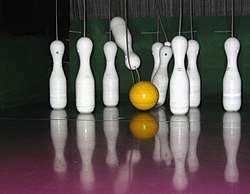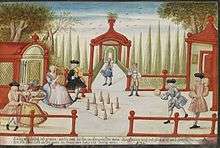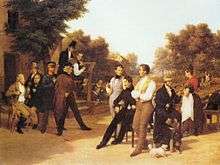Nine-pin bowling
Nine-pin bowling (also known as ninepin bowling, nine-pins, 9-pins, kegel, etc.) is a bowling game played primarily in Europe. European championships are held each year. Over 90,000 members are on teams in Germany, often playing in officially registered Bundeskegelbahnen (association bowling alleys) to be found in almost every sizable town. In Europe overall, there are some 130,000 players. Nine-pin bowling lanes are often found in Austria, Czechia, Slovakia, Belgium, Germany, Luxembourg, the Netherlands, Estonia, Switzerland, Serbia, Slovenia, Croatia, Poland, North Macedonia, Hungary, Brazil and Liechtenstein. The English-speaking countries, having a predominance of facilities for the modern ten-pin sport which originated in the United States, as well as regionally popular "small-ball" bowling sports of various types, do not have many facilities in existence for the nine-pin game in the 21st century. On the other hand, a modified version is played in the US state of Texas.
 Nine-pin bowling pins and ball, with pins attached to strings from the pinsetter. | |
| Highest governing body | WNBA |
|---|---|
| Nicknames | ninepins, 9-pin, kegel, kegeln |
| First played | Medieval times, Germany |
| Registered players | about 130,000 |
| Characteristics | |
| Contact | No |
| Team members | 6 per side + reserves |
| Mixed gender | Yes, separate competitions |
| Type | Team sport, ball sport |
| Equipment | Ninepin bowling ball |
| Venue | Ninepin bowling lane |
| Presence | |
| Olympic | No |
| World Games | 2005 |
European version

This game is played by rolling a ball down an alley towards nine pins. Unlike the ten-pin ball — and like the ones used for other American "small-ball" bowling sports such as five-pin bowling, candlepin and duckpin — the nine-pin ball has no finger holes, although there are also special balls with two finger holes designed for novice and amateur players. The lanes are 19.5 m (64 ft) long and have no oil on them. The nine pins (literally known as "cones" in the local languages) are placed in a square shape whose diagonal coincides with the axis of the lane. In modern systems the pins are reset by a pinsetter which lifts up the pins, each connected by a string on top, and lowers them back into the square shape for the next throw. The strings can be a positive factor for the bowler, as they can knock down other pins, or a negative factor, as they can get tangled up during the resetting process, though this is not always a problem as the machine can retract the strings for a short distance and allow a few seconds for them to untangle automatically. Compared with the ten-pin "free-fall" pinsetter, the string pin-setter has fewer moving parts, consumes less power, and costs less to maintain. String pinsetters can also be found on low-cost or recreational ten-pin lanes.
The game is played in 120 throws of four lanes. On each lane there are 30 throws; the first fifteen throws simply reset the pins after each throw, and the next fifteen throws reset the pins only after all the pins are knocked down (felled pins remain out of play until no pins are left). After each lane of 30 throws is completed, players shift to the next lane to the right (except for the last player, who moves to the first lane) until the tournament is over.
The ball is 16 cm (6.3 in) in diameter and weighs approximately 2.85 kg (6.3 lb), slightly smaller than the standard ten-pin ball. For younger and/or novice players, the ball is 14 cm (5.5 in) and weigh 1.9 kg (4.2 lb), often with two finger holes. The pins usually have a weight of approximately 1.3 kg (2.9 lb).
Points
Pin points are added up for each throw. Professional players knock down 700 pins and more. The unofficial world record is the result of Vilmoš Zavarko - 771 pins set up on February 8, 2020 in St. Martin. However, it is unofficial record, according to the WNBA's regulations, world records are recognized at World Championship events. This one belongs to the Hungarian Tamás Kiss, is 734 and was set in Brno on May 23, 2014.

League play is arranged in many WNBA member countries. Teams are composed of six competing players, of whom each one plays 120 throws, except if he is substituted. Two substitutes are allowed per game. As the play goes, each team sets up the lineup before the game. Players compete against each other for team points. A player who has more points on a lane gets one set point. If the players have knocked down the same number of pins, each gets 0,5 set points. The player with more set points gets a team point. If they have 2 set points each, the player with the higher total number of pins gets the team point. If they have the same number of pins, each team gets 0,5 team points. The team points are added up, the team with more total pins gets 2 additional team points. The team with more team points wins the game. If the team point score is 4:4, the game is tied. Those same rules apply for international matches. The winners of the National league championships enter the Champions League, the highest club competition.
Opposed to the league play, which is arranged in teams, there are National Championships, which are arranged individually. The player with the most pins combined is usually the winner. In some countries though, the national championships are competed through a knockout format, where the points are added up similarly as in the league play.
World records
Updated 10 June 2019.[1]
| Competition | Men | Women | ||||||||
|---|---|---|---|---|---|---|---|---|---|---|
| Result | Athlete | Nationality | Date | Location | Result | Athlete | Nationality | Date | Location | |
| Single (1x120) | 734 | Tamás Kiss | 23 May 2014 | 687 | Ines Maričić | 26 May 2019 | ||||
| Team (6x120) | 4012 | Claudiu Boanta Levente Kakuk Tamás Kiss Zsombor Zapletán László Karsai Norbert Kiss | 25 May 2013 | 3830 | Saskia Seitz Ute Beckert Daniela Kicker Ursula Zimmerman Simone Bader Corinna Kastner | 22 May 2009 | ||||
| Sprint (2x20) | 250 | Igor Kovačić | 21 May 2014 | 238 | Beata Włodarczyk | 25 May 2016 | ||||
| Combination (1x120 + 2x20) | 955 | Tamás Kiss | 24 May 2014 | 890 | Jasmina Anđelković | 26 May 2018 | ||||
European Nine-Pin Leagues
See World Ninepin Bowling Association members for partial list, till updated here.
American version
Origins
Standardized rules and organization of nine-pins were developed by the American Bowling Congress in 1895. Nine-pins was the most popular form of bowling in much of the United States from colonial times until the 1830s, when several cities in the United States banned nine-pin bowling out of moral panic over the supposed destruction of the work ethic, gambling, and organized crime. Tenpin bowling is said to have been invented in order to meet the letter of these laws, even with evidence of outdoor bowling games in 1810 England being bowled with ten pins set in an equilateral triangle as is done today in tenpin bowling. Today, nine-pins has disappeared from all of the United States except Texas, where, by 1837, ninepin alleys were numerous enough that rather than a ban, the 1st Congress of the Republic of Texas chose to subject them to an annual tax of $150, and all forms of bowling have remained legal and subject to taxation in Texas ever since. Whereas tenpin alleys were usually found in saloons and other establishments frequented exclusively by men, ninepin alleys were often built by clubs patronized by families.
Unique to Central Texas
By World War I most Texas bowling establishments, both private and commercial, had changed to ten-pins. However, nine-pins remained popular in predominantly German communities like Fredericksburg, New Braunfels and Bulverde, until the introduction of fully automated pin-setting machinery in the 1950s caused most of them to make the change as well. Those bowlers who still preferred the teamwork and camaraderie of nine-pins then moved to the nine-pins clubs in the small outlying communities of Bexar, Comal, and Guadalupe Counties.
Organizations like the Turner Club, Barbarossa, Bexar, Bulverde, Blanco, Bracken, Cibolo, Fischer, Freiheit, Germania (the oldest club, organized in 1889), Highland, Laubach, Marion, Martinez, Mission Valley, Solms, Spring Branch, and Zorn bowling clubs maintain the only active nine-pins leagues in the United States.
League organization and gameplay
These bowling clubs typically have league bowling Monday through Friday, dependent on the number of bowling lanes and number of league bowlers. The smaller clubs (Zorn, Barbarossa, and Laubach, for example) have only four lanes while the bigger clubs may have eight or more lanes. League bowling consists of two teams bowling head-to-head for three games, with each nine-pin team having six bowlers. Each game consists of six frames.
The rules of this game are slightly more complicated than the European version. Each bowler will roll the ball twice in each frame regardless of the number of pins knocked down on each roll. When a bowler’s turn is completed, the next bowler will not receive a “Full House” to bowl at: rather, the next bowler must attempt to knock down the pins that were left by the previous bowler. For example, if the first bowler is only able to knock down seven pins, the second bowler must attempt to knock down the remaining two pins. Should the second bowler be unsuccessful in knocking down both of these pins in the allotted two rolls, the third bowler will attempt to knock down the remaining pins. This will continue until the remaining pins are knocked down or until the end of the frame. Once all pins are knocked down, the “12-pin”/”Redhead” is left standing alone (see below), or the end of the frame is reached, all nine pins (a Full House) will be reset.
Something that makes nine-pin bowling different from ten-pin bowling is that the bowlers do not have to bowl in the same order in each frame. Each team can designate a bowler to “Captain” each game. This Captain has complete discretion in determining the bowling order in each frame. These decisions are made on-the-fly: If the remaining pins are on the left side, and there is a remaining bowler who is better than the rest on left side pins, the Captain will send that bowler. This gives the Captain the flexibility to help maximize the team’s score. However, each bowler must roll two balls in each frame.
The pins used in the Texas version of nine-pins are the same dimensions as those used in ten-pins, and the bowlers use ten-pin balls, with finger and thumb holes drilled in them.[2]
The pins are set up in a diamond (1-2-3-2-1) configuration. The pin exactly in the center has a special purpose in nine-pin bowling. This pin is typically painted red, either partially or completely, and is called the “12-Pin” or the “Redhead”. From front to back, the pins are 1) the Head Pin, 2) the Left Front Beer and Right Front Beer Pins, 3) the Left Corner, the 12-Pin/Redhead, and the Right Corner, 4) the Left Back Beer and Right Back Beer Pins, and, finally, 5) the Sleeper Pin.
Scoring
Scoring in nine-pin is also different. Each frame begins with a full house. If a bowler knocks down all nine pins in a full house, that bowler achieved a nine-ringer and is given a score of 9 with a circle around it. Note that the circle is just to show that this was a ringer. There are no additional points for a ringer. If a bowler knocks down all the pins except for the center pin in a full house that bowler achieved a twelve-ringer and is given a score of 12 with a circle around it. Again, the circle does not add additional points; it simply shows that a ringer was bowled.
If a bowler’s roll does not result in either “9” or “12” points, that bowler’s roll is given a “-“ (dash) or a “√” (check) which carries no point value. The one exception to this is the last ball rolled by the last bowler in the frame. This bowler will receive credit for the number of pins knocked down. For example, if the last bowler has rolled his second ball for this frame, and three pins remain standing (six pins knocked down), that bowler will receive credit for those six pins, regardless if that bowler knocked these six pins down or not.
When a bowler takes a turn and knocks down the remaining pins, that bowler receives nine points for that shot, regardless of the number of pins knocked down to receive these nine points. If a bowler knocks down the remaining pins, except for the center pin, that bowler receives 12 points for that shot regardless of the number of pins knocked down to receive those 12 points.
Because bowlers face the pins their teammates have left, the better teams are those who have a mix of bowlers that can “hit the left side”, “hit the right side”, or can “roll ringers”. This leads to “specialization”. A good team “Captain” can also help their team by sending the bowlers in the order that maximizes their success.
Typical nine-pin league bowling teams have both male and female bowlers with ages that span from teenagers up to 80- and 90-year-old great-grandparents. It is not unheard of for an 80-something grandmother to be on a bowling team because “she can hit the left side every time”.
Pin-setters
Nine-pin bowling also uses human “pin-setters” who have the responsibility of returning the bowling ball, shoving the fallen pins into the pit, and resetting the “Full House” as necessary. While this may be a throwback to a forgotten age, there are many civic leaders in the Guadalupe-Comal-Bexar counties whose first job was as a pin-setter.
References
- WNBA NBC Official World Records. According to the WNBA directive, official world records are set only at World Championship events.
- "Texas 9-Pin Bowling - Cultural Relic". youtube.com. Retrieved January 1, 2019.
- Pin (cones) Layout Yahoo Translation of cones
- Deutscher Kegler- und Bowlingbund (DKB, "German Kegel and Bowling Association") (in German)
- Nine-pin Bowling Computer Game (Nine-Pin Bowling Computer-Game for multiple platforms)